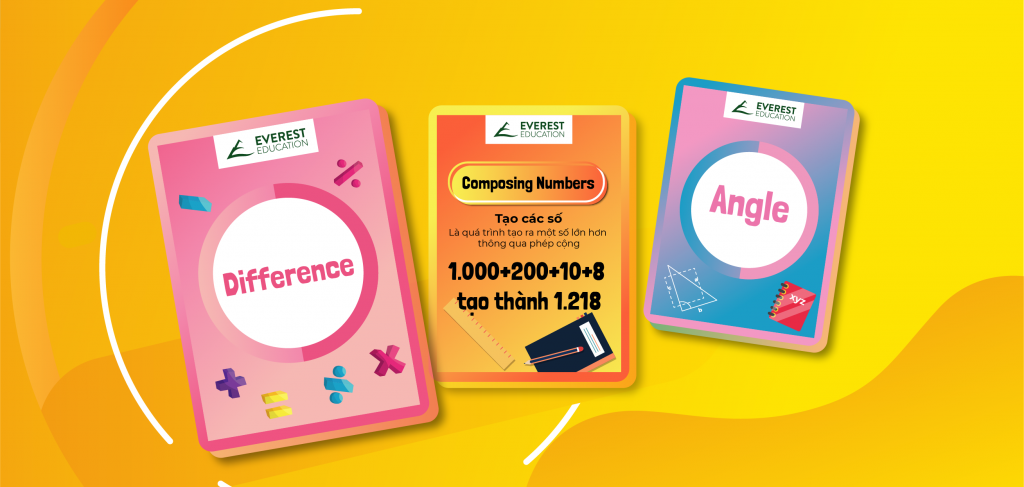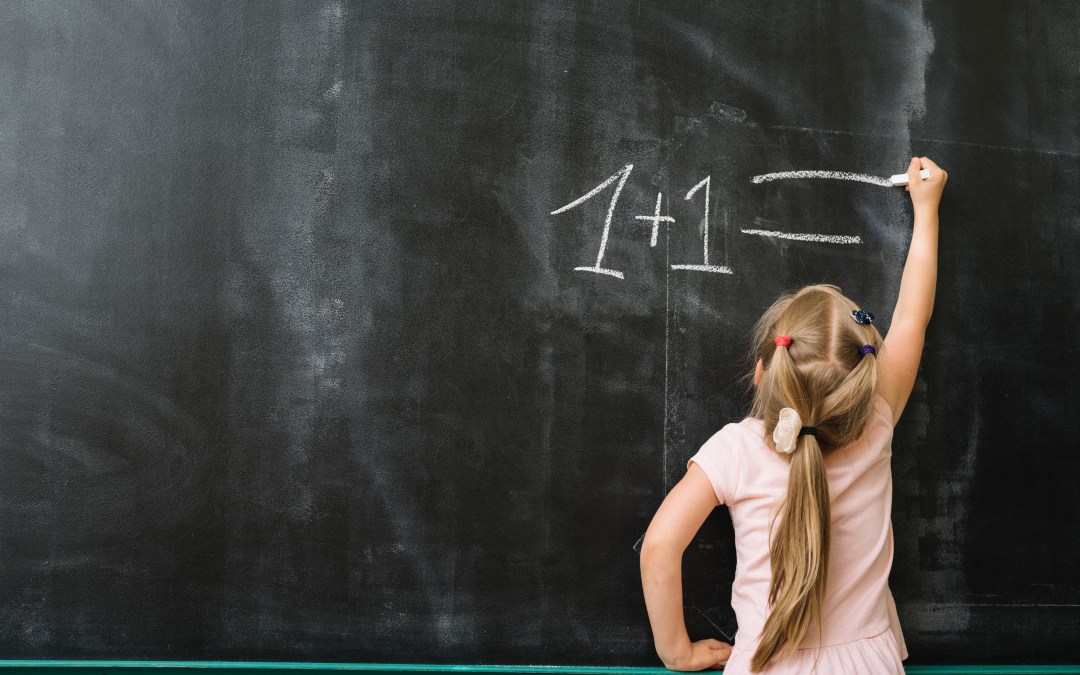Learning math is like learning a foreign language. In order to be successful in Math, students must become fluent with the vocabulary. To help children learn Math in a language that is not their first language, teachers and parents need to assess whether this is desirable and attempt to find meaningful, effective ways in which they are able to correctly use Mathematical terms and apply them to problem-solving.
As many parents have realized that throughout the time studying Math in English, your child will be introduced to a huge number of words and phrases, many of which may seem baffling – both to them and to you.
In this article, we list down the most important Math vocabulary words and concepts that every primary student should know. This list is designed to inform students, parents, and teachers of the vocabulary and meaning of terms in mathematics that students may have encountered in their primary school, in international Math contests, Math online learning sites… and will encounter when they transfer to post-primary education.
Please note that this is not a comprehensive glossary of every basic mathematical term that could come up throughout your child’s primary school life, merely the key ones they will need to form solid foundations in the subject.
| Term | Definition | Diagram/ Example | |
| A | Addends | Numbers are involved in an addition problem; a number that is added to another number | |
| Addition | Finding the total, or sum, by combining two or more numbers. | ||
| Acute angle | An Acute Angle is less than 90° | ||
| Angle | The amount of turn between two lines around their common point (the vertex). | ||
| Ascending order | Arranged from smallest to largest. Increasing. | 2, 4, 15, 31 are in ascending order. | |
| Area | The size of a surface. | ||
| Average | A calculated “central” value of a set of numbers. | ||
| B | Bar chart | A bar chart is a form of graph that displays information using rectangular bars to show value. | |
| Bar model | A bar model is a method that uses diagrams of rectangular bars to represent maths problems in a visual way | ||
| C | Circle | A continuous curved line, the points of which are always the same distance from center point. | |
| Circumference | The distance around the edge of a circle. Circumference of Circle = 2πr | ||
| Complementary angles | Two angles are complementary angles when they add up to 90° | ||
| Composite number | A whole number that can be made by multiplying other whole numbers. | ||
| Cone | A solid (3-dimensional) object that has a circular base joined to a point by a curved side. The pointed end of the cone is called the apex, whereas the flat surface is called the base. | ||
| D | Decimal | A decimal number (based on the number 10) contains a Decimal Point. | “forty-five and six-tenths” written as a decimal number |
| Decline | to gradually become less, lower | ||
| Decomposing number | Decomposing is when we break the number apart | ||
| Descending order | Arranged from largest to smallest. Decreasing. | For example, 210, 52, 11, 9, 2 are in descending order. | |
| Denominator | The bottom number in a fraction. | ||
| Diagonal | A line that goes from one corner to another, but is not an edge. | ||
| Diameter | The distance from one point on a circle through the center to another point on the circle. And it is twice the radius. | ||
| Difference | Difference means to subtract one value from another | ||
| Dividend | The number that you want to divide up. | ||
| Divisible | When dividing by a certain number gives a whole number answer | For example, 10 is divisible by 5, because 10 ÷ 5 = 2 exactly But 9 is not divisible by 2 because 9 ÷ 2 is 4 with 1 left over. | |
| Division | Division is splitting into equal parts or groups. | ||
| Divisor | The number we divide by. | ||
| E | Edge | An edge is the name for lines created when two faces in a 3D shape meet. | |
| Equal | Exactly the same amount or value | ||
| Even number | Any integer that can be divided exactly by 2 is an even number. | ||
| Equation | A mathematical statement shows that both sides equal the other. | For example, 12 – 5 = 3 + 4 | |
| Equilateral triangle | A triangle with three equal sides and three equal angles. | ||
| Equivalent fraction | The fractions that have different numerator and denominator but are equal to the same value. | ||
| F | Factor | Numbers we can multiply together to get another number. | For example, 2, 3, 4 and 6 are all factors of 12, and 12 can be divided into them exactly. |
| Fewer | Smaller quantity or amount. | ||
| Fraction | Shows how many parts of a whole: • the top number (the numerator) says how many parts we have. • the bottom number (the denominator) says how many equal parts the whole is divided into | ||
| G | Geometry | The branch of mathematics that deals with points, lines, shapes and space. | |
| Greater | Bigger.The symbol > means greater than | For example, 7 > 4 shows that 7 is greater than 4. | |
| H | Hypotenuse | The side opposite the right angle in a right-angled triangle. | |
| Hemisphere | A hemisphere is the half sphere formed by a plane intersecting the center of a sphere. | ||
| Hexagon | A hexagon is a 6-sided polygon | ||
| I | Increase | Make something bigger (in size or quantity). | |
| Integer | A whole number. It may be positive, negative, or zero. | ||
| Isosceles triangle | A triangle with two equal sides and two equal angles across from them. | ||
| L | Less than | Smaller.The symbol < means less than | For example, 4 < 7 shows that 4 is less than 7. |
| Line | A line is absolutely straight, has no thickness, extends in both directions without end. | ||
| M | Mean | Found by adding a set of values and dividing the total by the number of values in the set. | For example, the mean of 2, 4, 5, 7 and 12 is 6 because (2 + 4 + 5 + 7 + 12) ÷ 5 = 6 |
| Median | The median of a set of numbers is the middle number in that list. The numbers in the list must first be sorted into ascending order. | For example, the median of 1, 2, 3, 4, 5, 6, 7 is 4. | |
| Mid point | The middle point of a line segment. | ||
| Minuend | The first number in a subtraction. | ||
| Mixed number | A whole number and a fraction combined | For example, 5½ (five and a half) is a mixed number. | |
| Mode | The mode of a set of numbers is the one that appears most often. | For example, the mode of 2, 3, 4, 5, 5, 6, 7 is 5. | |
| Multiple | A multiple is the result of multiplying one integer by another. | ||
| Multiplication | The basic idea of multiplication is repeated addition. | For example: 5 × 3 = 5 + 5 + 5 = 15 | |
| N | Negative number | Less than zero. | |
| Numerator | Top number in a fraction. | ||
| Number line | A number line is a horizontal line, with numbers placed at equal or segments along its length. | ||
| O | Obtuse angle | An Obtuse Angle is more than 90° but less than 180° | |
| Odd number | Any integer that cannot be divided exactly by 2 is an odd number. | ||
| P | Pair | Two together. | For example, {12,11} is a pair of numbers |
| Parallel | 2 lines that always have the same distance apart and never touching. | ||
| Parallelogram | A Parallelogram is a flat shape with opposite sides parallel and equal in length. | ||
| Pentagon | A pentagon is a 5-sided Polygon | ||
| Percentage | Percentage means ‘out of 100’ and is used to show a number or ratio expressed as a fraction of 100. | For example, this 300.000VND jacket had 20% off in the Christmas sale. | |
| Perimeter | The total distance around the outside of a polygon. This distance is obtained by adding together the units of measure from each side. | ||
| Perpendicular | Two lines or line segments intersecting to form a right angle. | ||
| Polygon | A polygon is any 2D shape with straight, closed sides. | ||
| Prime number | A prime number is any number greater than 1 that can only be divided equally by itself and 1. | ||
| Prism | A prism is a 3D shape with two identical flat sides and ends. | ||
| Product | The answer when two or more values are multiplied together. | ||
| Q | Quotient | The answer after we divide one number by another. | For example, in 12 ÷ 3 = 4, 4 is the quotient. |
| Quadrilateral | A flat shape with four straight sides. | ||
| R | Radius | The distance from the center to the circumference of a circle | |
| Ratio | A ratio shows the relative sizes of two or more values. | For example, the ratio of boys to girls was 2:1, meaning there are two boys for every one girl. | |
| Remainder | An amount left over after division | ||
| Right angle | A right angle is an internal angle which is equal to 90° | ||
| Rhombus | A Rhombus is a flat shape with 4 equal straight sides. | ||
| S | Scalene triangle | No equal sidesNo equal angles | |
| Sequence | A sequence is a list of things (usually numbers) that are in order. | ||
| Set | A set is a collection of things, usually numbers. | ||
| Sphere | An object shaped like a round ball | ||
| Subtraction | Taking one number away from another. | ||
| Subtrahend | A quantity or number to be subtracted from another. | ||
| Sum | The result of adding two or more numbers. | ||
| Supplementary angles | The two angles are supplementary angles when they add up to 180° | ||
| Symmetry | When a picture or shape is the same on both sides, we call it ‘symmetrical’ | ||
| T | Trapezoid | A trapezoid is a 4-sided flat shape with straight sides that has a pair of opposite sides parallel | |
| Triangle | A triangle has three sides and three angles right arrow. The three angles always add to 180° | ||
| U | Unequal | Not equal. | |
| V | Vertex | A point where two or more line segments meet. A corner. | |
| Volume | The volume is the amount of space an object occupies, especially 3D shapes. | ||
| W | Weight | How heavy something is. | |
| Whole number | Whole numbers are simply the numbers 0, 1, 2, 3, 4, 5, … (no negative, fractional or decimal parts) | ||
| Word problems | Mathematical exercises presented in ordinary language rather than in mathematical notation. The most common types of word problems are distance problems, age problems, work problems, percentage problems, mixtures problems and numbers problems. | For example, Ann is three times as old as her little brother Bob. In five years, she will be only twice as old. How old are they now? |
>>> Parents can also download our free printable set of Math flashcards, and read the detailed guidance of how to use them with your child here: https://blog.e2.com.vn/use-flashcards-to-teach-your-kids-math-vocab/

Should you have any concerns or any topics you want us to cover, feel free to leave your comments below. You can subscribe to our newsletter to get the latest updates delivered straight to your inbox and find more parenting coverage at
https://blog.e2.com.vn/category/parents/













